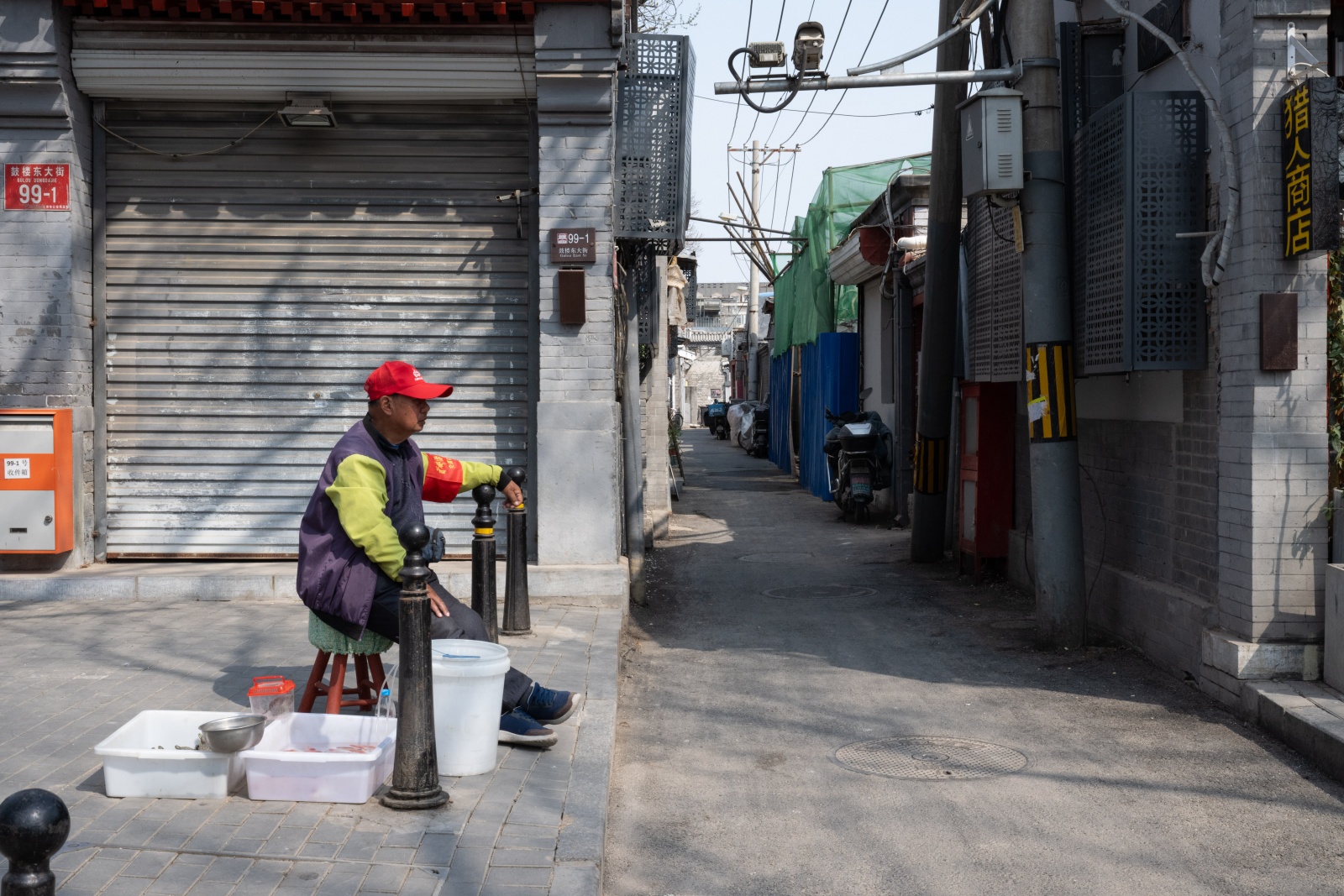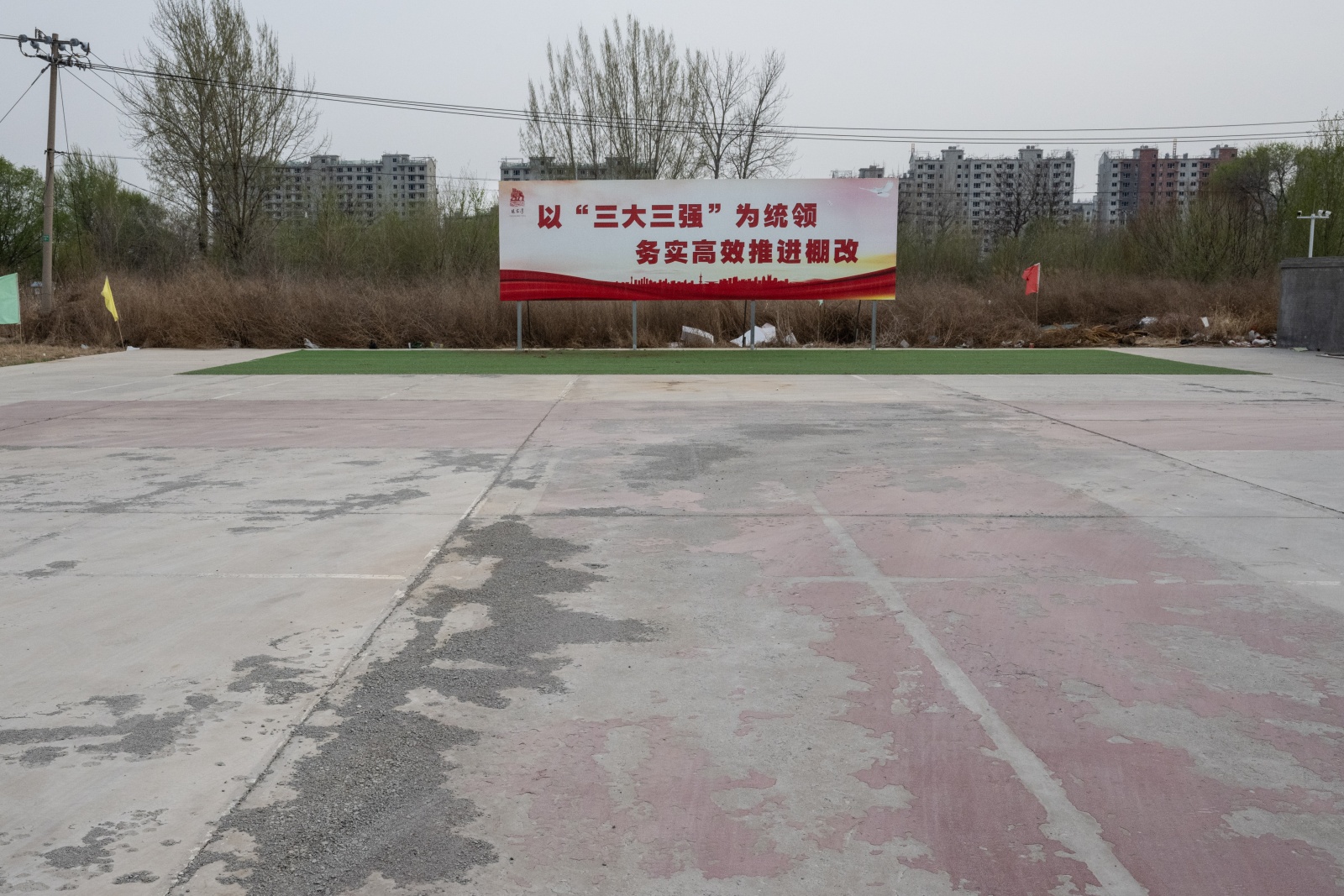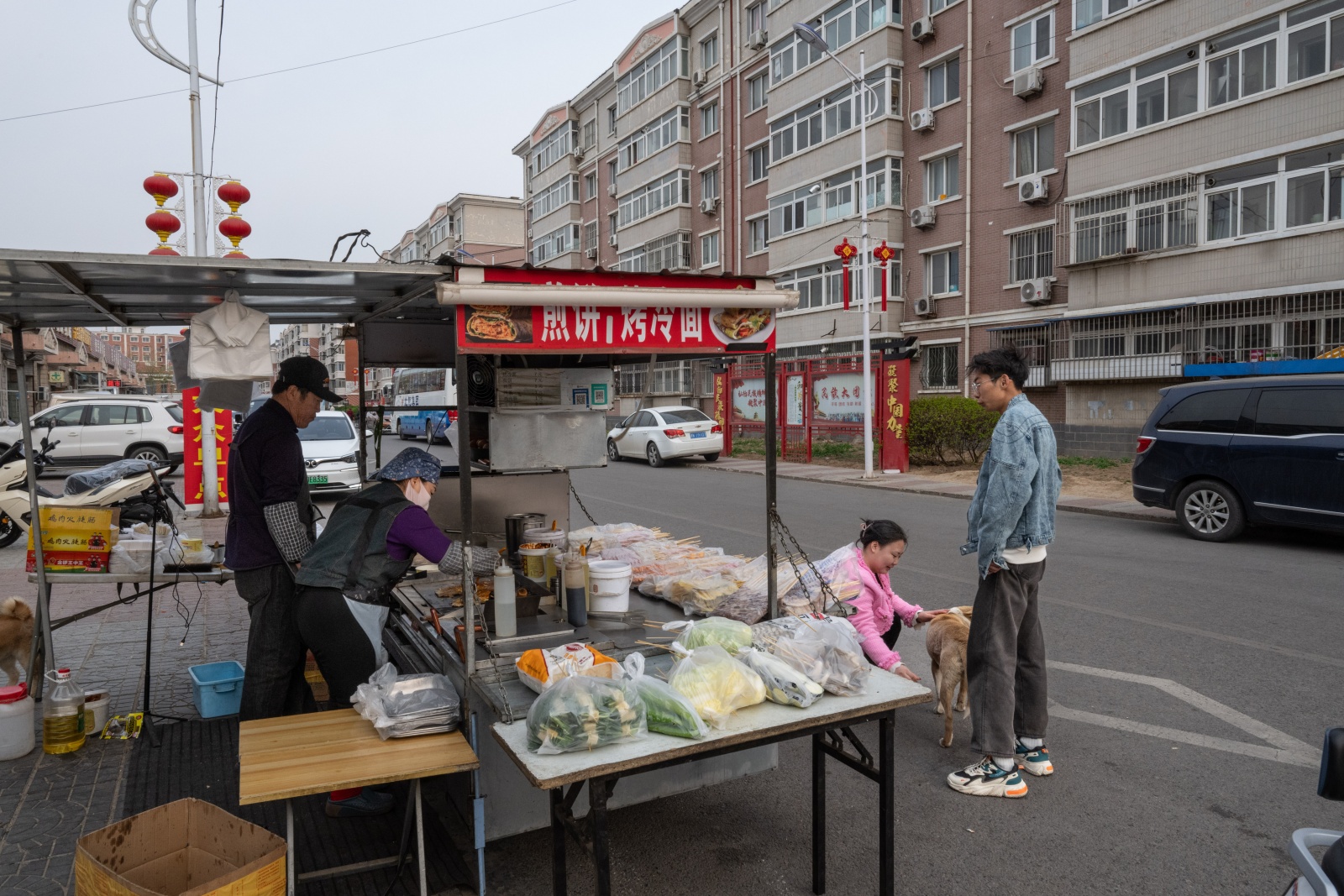Stay updated with the latest - Click here to follow us on Instagram
Xi Jinping’s recipe for total control: An army of eyes and ears
The Chinese Communist Party has long wielded perhaps the world’s most sweeping surveillance apparatus against activists and others who might possibly voice discontent.
 A faded propaganda poster depicting President Xi Jinping with the slogan 'People have faith, the country has power, there is hope for the nation' in Zhangjiawan, a suburb of Beijing, April 3, 2024.(Gilles Sabri/The New York Times)
A faded propaganda poster depicting President Xi Jinping with the slogan 'People have faith, the country has power, there is hope for the nation' in Zhangjiawan, a suburb of Beijing, April 3, 2024.(Gilles Sabri/The New York Times)Written by Vivian Wang
The wall in the police station was covered in sheets of paper, one for every building in the sprawling Beijing apartment complex. Each sheet was further broken down by unit, with names, phone numbers and other information on the residents.
Perhaps the most important detail, though, was how each unit was color-coded. Green meant trustworthy. Yellow, needing attention. Orange required “strict control.”
A police officer inspected the wall. Then he leaned forward to mark a third-floor apartment in yellow. The residents in that unit changed often, and therefore were “high risk,” his note said. He would follow up on them later.
“I’ve built a system to address hidden dangers in my jurisdiction,” the officer said, in a video by the local government that praised his work as a model of innovative policing.
This is the kind of local governance that China’s top leader, Xi Jinping, wants: more visible, more invasive, always on the lookout for real or perceived threats. Officers patrol apartment buildings listening for feuding neighbors. Officials recruit retirees playing chess outdoors as extra eyes and ears. In the workplace, employers are required to appoint “safety consultants” who report regularly to the police.
The Chinese Communist Party has long wielded perhaps the world’s most sweeping surveillance apparatus against activists and others who might possibly voice discontent. Then, during the coronavirus pandemic, the surveillance reached an unprecedented scale, tracking virtually every urban resident in the name of preventing infections.
 Volunteers from a neighbourhood committee stand watch on a street in Beijing, April 3, 2024. (Gilles Sabri/The New York Times)
Volunteers from a neighbourhood committee stand watch on a street in Beijing, April 3, 2024. (Gilles Sabri/The New York Times)
Now, it is clear that Xi wants to make that expanded control permanent, and to push it even further.
The goal is no longer just to address specific threats, such as the virus or dissidents. It is to embed the party so deeply in daily life that no trouble, no matter how seemingly minor or apolitical, can even arise.
Xi has branded this effort the “Fengqiao experience for a new era.” The Beijing suburb in the propaganda video, Zhangjiawan, was recently recognized in state media as a national exemplar of the approach.
 A police vehicle at the entrance of an apartment complex in Zhangjiawan, a suburb of Beijing, April 3, 2024. (Gilles Sabri/The New York Times)
A police vehicle at the entrance of an apartment complex in Zhangjiawan, a suburb of Beijing, April 3, 2024. (Gilles Sabri/The New York Times)
“Fengqiao” refers to a town where, during the Mao Zedong era, the party encouraged residents to “re-educate” purported political enemies, through so-called struggle sessions where people were publicly insulted and humiliated until they admitted crimes such as writing anti-communist poetry.
Xi, who invokes Fengqiao regularly in major speeches, has not called for a revival of struggle sessions, in which supposed offenders were sometimes beaten or tortured. But the idea is the same: harnessing ordinary people alongside the police to suppress any challenges to the party and uphold the party’s legitimacy.
The party casts this as a public service. By having “zero distance” from the people, it can more quickly gather suggestions about, say, garbage collection or save residents the trouble of going to court over business disputes. Instead, conflicts are hashed out by party mediators.
Xi frequently points to the Fengqiao experience as proof that the party is responsive to people’s needs and desires, even as he has smothered free expression and dissent.
 A volunteer from a neighbourhood committee keeps watch along a street while also feeding goldfish in Beijing, April 3, 2024. (Gilles Sabri/The New York Times)
A volunteer from a neighbourhood committee keeps watch along a street while also feeding goldfish in Beijing, April 3, 2024. (Gilles Sabri/The New York Times)
It is also an effort to assert his political legacy. Top officials have hailed Fengqiao as an example of Xi’s visionary leadership, while scholars have described it as “a model for showcasing Chinese governance to the world.”
The campaign strengthens Beijing’s repressive abilities at a time of mounting challenges. With China’s economy slowing, protests about unpaid wages and unfinished homes have increased. Tensions with the West have led Beijing to warn of omnipresent foreign spies. The party has also tightened scrutiny of groups like feminists, students and LGBT rights activists.
In the name of Fengqiao, the police have visited Tibetans, Uyghurs and other minority groups in their homes, promoting party policies. Companies have been required to register their employees in police databases. Government workers have given “anti-cult” lectures at churches. Police officers and judges have been installed in elementary schools as “deputy principals of law,” keeping files on students’ perceived risk levels.
But by blocking even mild or apolitical criticism, the party could also erode the very legitimacy it is trying to project.
Xi’s interest in the Fengqiao experience dates back two decades, to when he was still ascending the ranks of power.
The year was 2003, and Xi had just been named party secretary of Zhejiang province in China’s east. China’s economic opening had brought great wealth to the province, but also led to rising crime. Xi was looking for a solution. According to official media reports, he turned to a small Zhejiang town called Fengqiao.
 A billboard with official slogans promoting the renovation of ‘shantytowns’ at the site of a demolished village in Zhangjiawan, a suburb of Beijing, April 3, 2024. (Gilles Sabri/The New York Times)
A billboard with official slogans promoting the renovation of ‘shantytowns’ at the site of a demolished village in Zhangjiawan, a suburb of Beijing, April 3, 2024. (Gilles Sabri/The New York Times)
The town had entered party lore in the 1960s, after Mao exhorted the Chinese people to confront “class enemies,” such as landlords or rich farmers. In the official telling, Fengqiao residents at first clamored for the police to make arrests. But local party leaders instead urged the residents themselves to identify and “re-educate” the enemies.
Ultimately, nearly 1,000 people were labeled reactionaries, according to Fengqiao officials. They and their families had trouble finding work, going to school or even getting married. Mao declared the “Fengqiao experience” a model for the country. Not long after, he launched the Cultural Revolution, another mass movement that led to a decade of bloodshed.
After Mao died, the phrase fell out of favor, as his successors distanced themselves from the chaos of his rule.
Xi, though, embraced the phrase. His first visit to Fengqiao in 2003 was to the local police station, where he inspected an exhibition about the 1960s. Months later, he visited again and praised the idea of nipping problems in the bud. “Though the situation and responsibilities we face have changed, the Fengqiao experience is not outdated,” he said.
Xi’s call for more social control was part of a broader shift by the party, amid the rapid change of the 2000s, toward “stability maintenance” — a catchall term for containing social problems and silencing dissent.
 A street side food vendor, some of whom are complaining about stepped-up policing that restricts where they can set up, in Zhangjiawan, a suburb of Beijing, April 3, 2024. (Gilles Sabri/The New York Times)
A street side food vendor, some of whom are complaining about stepped-up policing that restricts where they can set up, in Zhangjiawan, a suburb of Beijing, April 3, 2024. (Gilles Sabri/The New York Times)
After Xi became top leader in 2012, he redoubled that focus. Mentions of Fengqiao in state media became ubiquitous. Then came the coronavirus pandemic — and the government began tracking individuals’ movements down to the minute.
It did so partly through technology, requiring residents to download mobile health apps. But it also leaned on old-fashioned labor. Using a method called “grid management,” the authorities divided cities into blocks of a few hundred households, assigning workers to each. Those workers went door to door to enforce testing requirements and quarantines, sometimes by sealing people into their homes.
State media hailed China’s early success in containing COVID as proof of the Fengqiao experience’s continued utility.
When people began to chafe at the restrictions — culminating in nationwide protests in 2022 — the granular approach proved its utility in another way, as the police used facial recognition cameras and informants to track down participants.
“The architecture is there,” said Minxin Pei, a professor at Claremont McKenna College who recently published a book about China’s surveillance state. “After three years of lockdowns, seeing how the system works probably gave them a lot of insights.”
The COVID controls are gone. The stepped-up surveillance is not.
It is clear now that the government’s heightened intrusiveness during the pandemic was an acceleration of a longer-term project. Xi’s goal is to deploy the masses to bolster the party, as Mao had done, but without the turmoil. That is where technology and the police come in, to ensure people never slip out of control.
“This is the next iteration” of the party’s obsession with stifling unrest, said Suzanne Scoggins, a professor at Clark University in Massachusetts who has studied Chinese policing.
And Beijing is pushing to expand it rapidly. It has encouraged local governments to hire many more workers to watch assigned grids. Last month, the party also issued its first-ever top-level guidance on the management of such workers, calling for stronger ideological training and formalized rewards and punishments.
Those new grid monitors will supplement the extensive ranks of China’s surveillance workers, which on top of uniformed police and party workers also include as many as 15 million ordinary people recruited as local government informants, according to Pei’s research.
Already, some community workers and police officers have complained on social media of being overworked.
The party’s tightening grip could also stifle the dynamism that it needs to revive the economy. A fried chicken vendor in Zhangjiawan, who gave only her surname, Ma, said she had not made enough money to pay her rent for three months, in part because constantly patrolling officers prohibited her from setting up her cart on the sidewalk.
“If the economy suffers, then there will be security problems,” she said. “People need to eat. If they get anxious, things will get messy.”
- 01
- 02
- 03
- 04
- 05






























